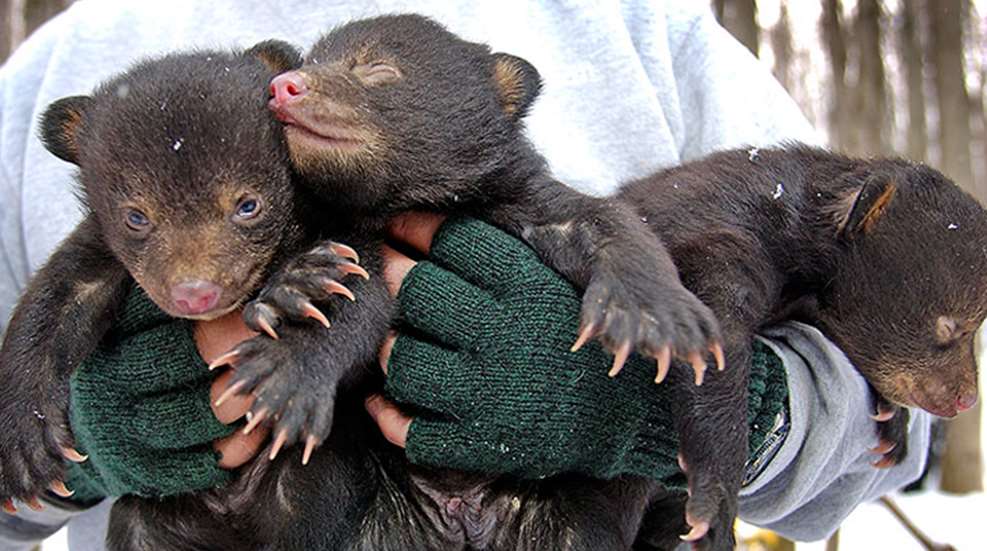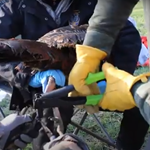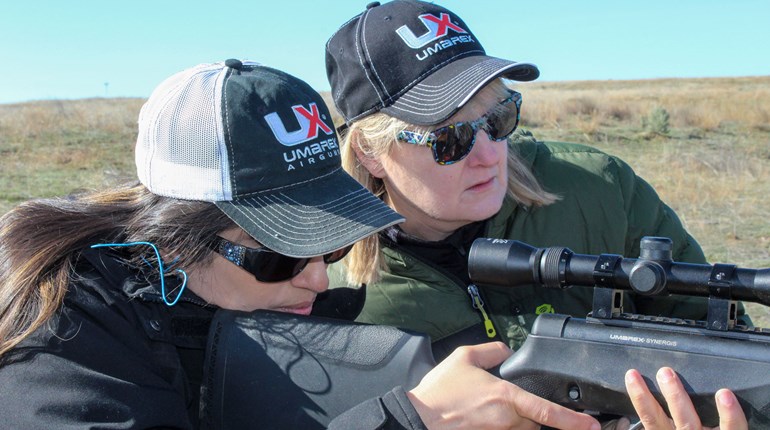
Mark sneaks quietly into the den, cradling the cub in a large hand. He is as silent as possible, for if he wakes the sleeping black bear, his mission-and his person-will be endangered. Ever so gently, he settles the cub in next to the sleeping giant and watches it snuggle into its new home. He backpedals out of the cave and breathes a sigh of relief. Mission accomplished!
Setting up covert wildlife adoptions for orphaned bear cubs is all in a day's work managing wildlife. So is removing sick animals from the herd and even banding rattlesnakes. Modern wildlife managers like Mark have brought dozens of species back from the brink of extinction. Their accomplishments may make them seem like modern-day medicine men, but what they do is well rooted in science.
Wolfgang works his way uneasily through the tall grass, wearing a pink Dora backpack and listening for the subtle buzz of a rattlesnake. He is assisting Yuman Lee of the Michigan Natural Features Inventory in a quest for endangered massassagua rattlesnakes. They capture a small plump specimen using a long set of tongs, then write down information about its health and markings. Yuman pulls out several bottles of nail polish. Wolfgang picks green and white for his favorite college team, and begins carefully painting the rattle of the pit viper. In addition to marking the scales in a pattern, this is one way to identify the reclusive snakes. Wolfgang and Yuman carefully release the small pit viper into the grass where it was captured, participating in the process of making the ecosystem a healthier, more colorful place for all species.
Why would anyone want to worry about these snakes, and how do they matter in the big picture? “It's about making sure that there isn't too much of one species and too few of another,” said Kevin Frailey, Director of Education for the Michigan Department of Natural Resources. In Michigan, these snakes are protected because they make a great dent into pest populations. In Texas, however, rattlers are rounded up and removed because there are too many of them. All of these decisions are made by wildlife managers, men and women who look into the hidden mysteries of nature.
Focusing on one drop in a rainbow doesn't provide a view of the rainbow. Nor does looking at only one type of wildlife manager or animal species. The “big sky” view is that individual wildlife managers working as a team have led us from wildlife ruin into a golden age, flush with plants and animals. Right now, many animals are present in higher numbers than they were before European settlers came. Like the spectrum of the rainbow, there are a variety of professions that add up to make this big picture work. Fisheries biologists, furbearing animal specialists and even rangers and conservation officers are all part of the wildlife management team. Together, using math, chemistry, biology, lunar tables, climatology and geography, combined with intuition, they seem to perform miracles.
It wasn't always so. One hundred years ago, mankind had nearly wiped the land clean of many species. The American bison was nearly extinct, deer populations at an all-time low, turkeys in deep decline, and some species of ducks and fish were rarely seen. Wildlife managers didn't exist.
It was time for change. Michigan led the way with the first wildlife manager ever. His job was to assess the damage caused by poor land use and help restore the wilderness. Soon, other states began to follow suit, and a program to train wildlife managers was created throughout the nation.
Wildlife managers have a secret weapon at their disposal that makes this all possible: a group of individuals that logs plenty of time in nature, and therefore has more awareness of what's happening in fields, lakes and streams. These modern-day Daniel Boones? Hunters and anglers, who have proven invaluable to wildlife restoration. When no one else knew wolves had returned, hunters made the call. If unusual insects are invading the forests, they see it first. When fish populations go down, it isn't scientists in laboratories that are always the first to know, it is fishermen. Their observations have made all the difference between species' survival and demise. Hunters and anglers implemented a licensing system that limited how many animals one could take. They asked to be taxed on their guns and ammo, rods and reels. This tax would go toward restoring game and nongame wildlife species.
Today, deer populations are at an all-time high, wild turkey numbers are exploding, and formerly threatened species like Kirtland's warblers and wolves are thriving! Clearly, this partnership between wild life managers and outdoors people has worked.
Conservation Officer Chris Thomas agrees. Every foray into the forest leads him into contact with hunters and anglers, who are an invaluable source of information-even if it is an encounter with poachers.
“Drop your nose to the ground!” Steve Huff whispers intensely. The ground is muddy and the man's face will be, too, in a moment. Sgt. Thomas and his partner, Huff, spend dark moonlit nights hiding in the trees, spying on poachers. In this case, illegal anglers are using a dip net to catch walleye. Catching the bad guys is part of their job, but so is noticing if that there are more or fewer walleyes in the nets than in the past. Paying attention to these things helps conservation officers collaborate with other wildlife managers, such as biologists, to write laws about how many fish should be legal to take, and what size. Talking to the hunters and anglers is even more important. “The information they provide us impacts the way laws that protect wildlife will be written,” stated Sergeant Thomas. “A biologist checks their nets and animals and plants to see things the habitat is showing them. When they want to pass a new law, the information from those out in the field is presented to the biologists to help make better laws.”
Information is crucial. How many animals live in a given area? What is the male-to-female ratio? How many babies do they have? How long do they live? Hunters are often required to turn over skulls or carcasses of animals they take to wildlife managers to survey how animal populations are doing. The information is taken to laboratories and carefully recorded. It can alert wildlife managers to the spread of a disease, so that they can act accordingly to protect animals and humans. It's also a goldmine of information about whether pesticides are getting into the food web, and if something must be done.
In 1900, it appeared that wildlife would disappear within a few generations. Maybe it looked that way then, but it certainly doesn't now. Today, a beaver's tail smacks a pond into silence. Whitetail stop by to drink after a day of lazing in the sun, as amethyst dusk sets. A crow calls and a turkey gobbles on its roost in response. Ducks pass overhead and the waters are clear. A passing hunter scouts the location for his next hunt, taking note of it all, as an angler packs up his tackle box and heads for home.
The chain of information about the natural world is passed from hunters and anglers to various wildlife managers, such as conservation officers, biologists, rangers and directors of wildlife agencies. It is analyzed, and ultimately the wildlife managers decide what to do with that information. Wildlife managers can hold the fate of an ecosystem in their hands. Usually, they succeed, but sometimes they fail. For example, Spanish olives were introduced into some states as cover for turkeys, but became an invasive plant species that was impossible to eradicate. Biologists accidentally introduced a larger strain of wolves into Yellowstone, resulting in reduced elk numbers. However, overall, wildlife managers have succeeded beyond our wildest dreams. Nearly every stream you fish in has been touched by their hands. Nearly every animal species has benefitted from their efforts, and thanks to them we have come back from the brink of disaster. Next time you see someone wearing a wildlife manager's uniform, you may want to thank them, for they are part of the reason the land is fat and happy with wildlife for us to enjoy.






































